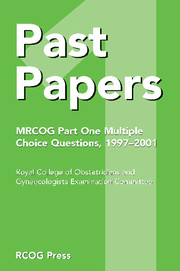Book contents
- Frontmatter
- Contents
- Introduction
- March 1997 – Paper 1
- March 1997 – Paper 2
- September 1997 – Paper 1
- September 1997 – Paper 2
- March 1998 – Paper 1
- March 1998 – Paper 2
- September 1998 – Paper 1
- September 1998 – Paper 2
- March 1999 – Paper 1
- March 1999 – Paper 2
- September 1999 – Paper 1
- September 1999 – Paper 2
- March 2000 – Paper 1
- March 2000 – Paper 2
- September 2000 – Paper 1
- September 2000 – Paper 2
- March 2001 – Paper 1
- March 2001 – Paper 2
- September 2001 – Paper 1
- September 2001 – Paper 2
- Index
March 1998 – Paper 2
Published online by Cambridge University Press: 05 July 2014
- Frontmatter
- Contents
- Introduction
- March 1997 – Paper 1
- March 1997 – Paper 2
- September 1997 – Paper 1
- September 1997 – Paper 2
- March 1998 – Paper 1
- March 1998 – Paper 2
- September 1998 – Paper 1
- September 1998 – Paper 2
- March 1999 – Paper 1
- March 1999 – Paper 2
- September 1999 – Paper 1
- September 1999 – Paper 2
- March 2000 – Paper 1
- March 2000 – Paper 2
- September 2000 – Paper 1
- September 2000 – Paper 2
- March 2001 – Paper 1
- March 2001 – Paper 2
- September 2001 – Paper 1
- September 2001 – Paper 2
- Index
Summary
1. The oxidation of pyruvate to carbon dioxide
A. occurs exclusively in mitochondria.
B. can occur under anaerobic conditions.
C. involves intermediates that are also involved in amino acid catabolism.
D. is regulated by the concentration of acetyl coenzyme A in the cell.
E. is impaired in thiamine deficiency states.
2. Uric acid
A. is formed from the breakdown of purines.
B. serum concentrations are raised during normal pregnancy.
C. serum concentrations are increased during thiazide diuretic therapy.
D. is reabsorbed in the proximal renal tubule.
E. is excreted unchanged in the urine.
3. Creatinine
A. is filtered out by the glomerulus.
B. is reabsorbed significantly by the proximal tubules.
C. plasma concentration increases after protein ingestion.
D. has a plasma clearance rate equivalent to renal plasma flow.
E. plasma concentration increases during the first trimester of pregnancy.
4. Plasma albumin binds the following
A. free fatty acids.
B. triglycerides.
C. oestradiol.
D. bilirubin.
E. iron ions.
5. In the digestive system
A. polysaccharides are broken down mainly in the stomach.
B. one molecule of sucrose forms two molecules of glucose.
C. glucose transport into the cell depends upon the active transport of sodium ions.
D. fructose is mainly absorbed by simple diffusion.
E. lactase activity increases during childhood.
6. Methionine
A. is an essential amino acid.
B. is a sulphur-containing amino acid.
C. cannot be converted to cystine by the fetal liver.
D. cannot cross the placenta.
E. is reabsorbed in the proximal convoluted tubule in the kidneys.
- Type
- Chapter
- Information
- Past Papers MRCOG Part One Multiple Choice Questions1997–2001, pp. 51 - 60Publisher: Cambridge University PressPrint publication year: 2004



